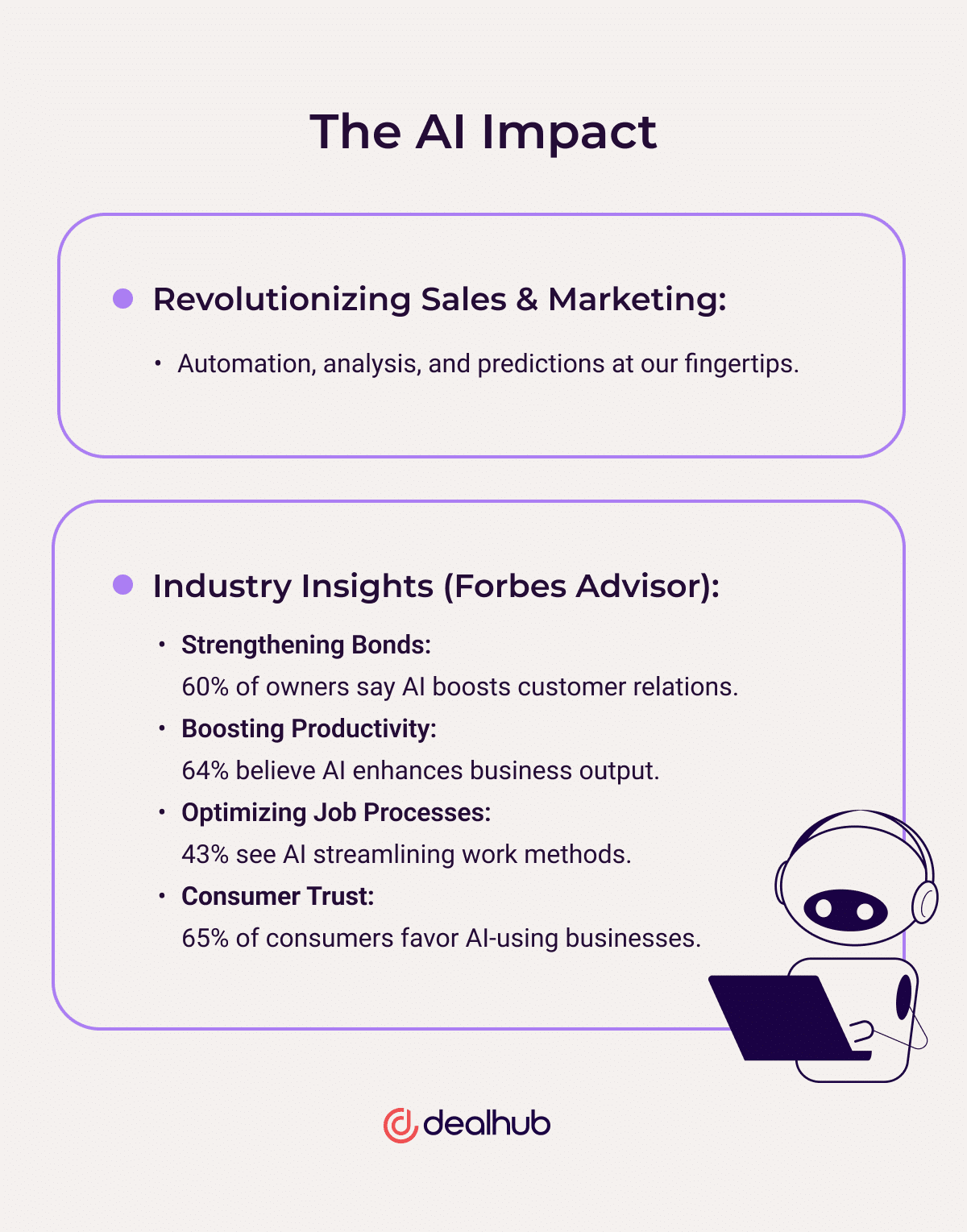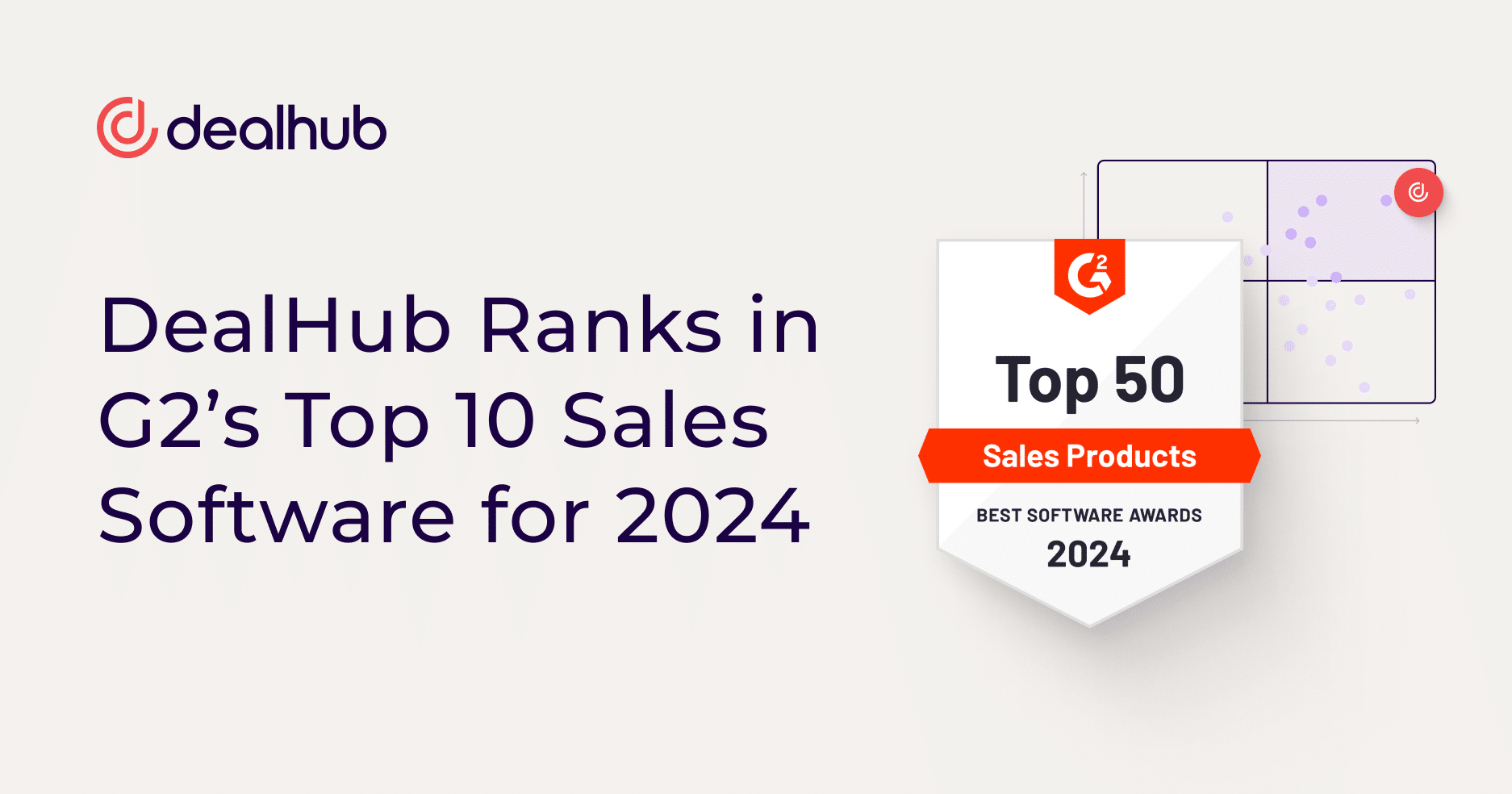Both companies and customers are readily embracing the technology. According to Forbes Advisor:
- Over 60% of business owners believe AI will improve customer relationships
- 64% of business owners say that AI will enhance business productivity, and 43% think it will streamline job processes
- 65% of consumers still trust businesses that employ AI technology

So buckle up! In this article, we’ll dive into the exciting world of AI and its game-changing sales applications – specifically in boosting revenue through predictive analytics, automation, and personalization.
The role of AI in growing revenue
AI is more than just a buzzword for modern sales leaders — it’s a competitive advantage. The fusion of automation, data analytics, and predictive capabilities has empowered the most successful businesses to reach unparalleled heights in revenue growth.
With their iterative learning capabilities, AI algorithms can now automate tasks and streamline workflows that used to consume valuable hours, allowing sales and marketing teams to focus on strategic initiatives that move the needle. While AI handles tedious admin, human sales representatives can build and nurture lucrative client relationships.
AI can be leveraged across all aspects of sales and marketing. So, if you’re still looking for ways to integrate AI into your business, start here! We’re laying out four key areas AI helps teams grow revenue – and some examples to show how easily it integrates into your business processes.
Harnessing the power of predictive analytics
Predictive analytics, the art of using historical data to forecast future outcomes, has become a cornerstone of modern revenue generation. In fact, 95% of companies now integrate AI into their marketing strategy for this very purpose. Imagine having a crystal ball that unveils the future behaviors of your customers. That’s AI in a nutshell! By analyzing data patterns and trends, AI algorithms can predict customer preferences, buying behaviors, and even potential churn.

Examples of predictive analytics in revenue generation
Let’s take a closer look at predictive analytics in action. Picture a scenario where you can foresee future actions. Would that change how you market a product or when you offer a discount (and to whom)? With AI, users can use predictive analytics to gain insights into:
- Customer behavior. Using AI, companies can analyze historical data, such as past purchases, browsing behavior, and engagement patterns, to forecast future actions. This allows organizations to adjust their marketing efforts, offers, and promotions, maximizing the chances of conversions and upsells.
- Demand forecasting. Predictive analytics can analyze historical sales data, seasonal trends, market conditions, and even external factors like weather patterns to forecast future demand accurately.
- Churn and customer retention. AI can flag customers who show dissatisfaction or reduced activity by analyzing customer engagement, interactions, and past behaviors to help develop targeted retention strategies.
- Lead scoring and conversion. Companies can use predictive analytics to assign scores to leads based on customer characteristics, behaviors, and interactions with the brand. This ensures sales teams prioritize leads with the highest potential for conversion.
- Cross-selling and upselling. By identifying products or services often bought together or complementing a customer’s current selection, businesses can cross-sell, upsell, and present tailored recommendations to enhance the customer’s experience and increase revenue.
Streamlining and automating tasks
The sheer volume of repetitive tasks can bog down productivity in sales and marketing. However, more and more businesses (66%) are taking action to automate business practices. AI-powered automation liberates teams from mundane tasks and empowers them to focus on strategic thinking. After all, automation isn’t about replacing the human touch; it’s about amplifying it.
Examples of automation in sales and marketing
AI has made its way into sales and marketing in a variety of ways, including:
- Email marketing campaigns. With predictive analytics, automation tools can analyze subscriber behavior, preferences, and engagement history to determine the best time to send emails and the content and offers that are most likely to resonate.
- Customer support chatbots. AI-powered chatbots can provide instant and accurate customer support 24/7. These virtual assistants use natural language processing to understand customer inquiries and provide relevant solutions or direct customers to appropriate resources.
- Social media management. Automation tools can schedule and publish social media posts, allowing businesses to maintain a consistent online presence without manual intervention. These tools can also monitor social media interactions, providing insights into customer sentiments and engagement trends.
- Content Distribution: Automating content distribution ensures that relevant content reaches the right audience at the right time. Through AI-driven algorithms, businesses can segment their audience and distribute content via email, social media, and other channels, increasing visibility and engagement.
Unveiling insights from sales and marketing datasets
The digital age has blessed companies with abundant data, and making sense of it all is a challenge. But, thanks to AI, 40% of companies surveyed by Forbes in 2023 use AI for data aggregation. By leveraging AI algorithms, businesses can extract meaningful insights from mountains of data, uncovering insights that can shape their revenue strategy.
Examples of data-driven insights and opportunities
Parsing through large amounts of data quickly and providing actionable insights is a powerful AI feature. After digesting raw sales and marketing information, AI can help a company:
- Understand customer preferences and trends. By examining purchasing history, browsing behavior, and demographic data, companies can identify patterns that help them tailor their products, services, and marketing strategies to better meet customer needs.
- Identify market opportunities. By analyzing market trends, consumer behaviors, and competitive landscapes, businesses can identify niches where demand is growing or where gaps exist in the market.
- Optimize pricing strategies. Data-driven pricing strategies can maximize revenue by analyzing customer behavior, market trends, and competitive pricing. Using AI, businesses can adjust prices dynamically to align with demand and customer willingness to pay.
- Improving processes and efficiency. Businesses can identify bottlenecks, streamline processes, and allocate resources more effectively by analyzing workflow data.
Implementing personalization
The age of one-size-fits-all marketing is long gone. Modern consumers demand personalized experiences that resonate with their unique preferences. And companies are responding! In fact, 53% of sales leaders expect personalized outreach via AI to significantly impact business.
Examples of personalization in sales and marketing
AI helps sales and marketing personalize interactions via:
- Customer segmentation and targeting. Personalization starts with understanding your audience. By segmenting your customer base based on demographics, behavior, preferences, and purchase history, you can tailor marketing messages and offers to specific groups.
- Dynamic content generation. Dynamic content adapts in real-time based on user interactions, creating a tailored experience for each individual. Websites and emails can display content such as product recommendations, images, and messages that align with the user’s browsing history and preferences.
- Retargeting and remarketing. Retargeting involves showing personalized ads to users who have previously interacted with your company’s website or products. This keeps your brand in mind and encourages users to return and complete a desired action, such as purchasing or filling out a form.
- Predictive personalization. Predictive personalization uses AI and machine learning to anticipate user preferences and behaviors. By analyzing historical data, algorithms can predict what products or content a user will likely engage with next.
The future of AI and revenue generation
The AI journey is far from over. As technology advances, so does AI’s potential to revolutionize revenue generation. In the future, expect ever-more advanced AI to offer:
- More sophisticated, increasingly accurate forecasting
- Hyper-personalization down to each individual customer
- Predictive customer service
Explore the transformative potential of AI in revenue generation
AI can unlock continuous value in a world where every click, view, and purchase leaves a digital footprint. As businesses strive for growth and relevance, embracing AI is not just an option—it’s a necessity. The future is bright, and those who harness AI’s power stand poised to reshape revenue generation and redefine what’s possible.
The amalgamation of automation, predictive analytics, data-driven insights, and personalization has helped sales and marketing teams grow more attuned to what a customer really wants. So, whether you’re a startup or an industry titan, embrace the AI advantage and chart a course for revenue growth that knows no bounds.



